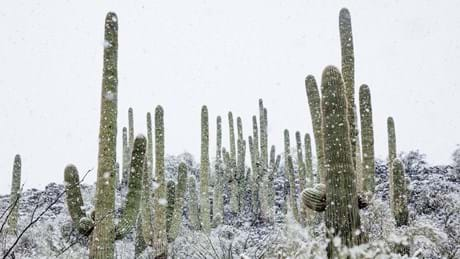The Fynbos must burn every 10-15 years to disperse seeds, help plants to germinate and regenerate the landscape.
Facts and fun in The Green Planet Season 1
Help your little scientists grow with the BBC’s new nature documentary The Green Planet Season 1

Did you know that there’s a South African plant that tricks dung beetles into burying its seeds by making them look – and smell – exactly like local antelope dung? Your kids can learn all about it in episode 3 of the new BBC nature documentary series The Green Planet, narrated by Sir David Attenborough. This is the very first time that Ceratocaryum’s life cycle with the dung beetle has ever been caught on camera, and you can watch every moment in brilliant detail together.
And there’s so much more original behaviour for your kids to explore in this series, which is packed with fascinating plant facts that will make the world come alive around them, from icy Finland, to the Amazon rainforest, to the Kalahari. It’s the ultimate watch-as-a-family series this February on DStv.
Watch BBC Earth now Set a reminder
South Africa On Screen
There’s nothing more inspiring for a budding naturalist than knowing you can see the wonders that the TV shows in your very own country. It’s the see-for-yourself factor. And the Green Planet team visited South Africa to capture footage of a few extraordinary plants in the Western Cape and in the Karoo.
Episode 3 producer Rosie Thomas and her team were determined to capture footage of a Fire Lily. But that meant having to wait for a fire to sweep through the fynbos, then capturing those first tender green shoots pushing through the cinders and ash. According to the show's researchers, the Fire Lily bulb is triggered into sprouting when smoke particles sink into the soil. If it wins the race to bloom first, it will be the only flower available to insects, who’ll find it easy to go from Fire Lily to Fire Lily, pollinating along the way.
“We heard about the Fire Lily but it’s so rare to see that nobody really knew where we would be able to find them,” says Rosie. “The Fire Lily waits for its moment and it rises up out of the ashes about 4 days after a fire has passed through and then it blooms and gets pollinated and then it goes back underground to wait for another fire. What we needed was a huge network of people. (It was a) collaboration between the landowners and the scientists. We worked with various different fire organisations to be able to capture all the different parts of that story and it’s a really emotional piece. The Fire Lilies that we actually found, the land owner didn’t even know that he had them on his land because they had been underground for 15 years. It was extraordinary to see these little pops of red against a completely charred landscape.”
“1 of the main scientists we worked with, who appears in that episode is Jasper Slingsby (the ecologist). Another we worked with, who doesn’t appear, who was key in us getting the science right, was a man called Rupert Koopman (the botanist and Conservation Manager at the Botanical Society of South Africa). They were really key to us being able to understand the processes,” says Rosie.
While filming the Fire Lily, the Green Planet team were also able to capture the fascinating relationship between the Ceratocaryum and the dung beetle. “They really had this pungent odour,” reveals Rosie. “The seeds make the beetles do the work for them. The beetles roll away the seeds and bury them underground at the exact right depth for germination. To actually be there and see it was a very amusing thing.”
In the Karoo (filming episode 4), the Green Planet team focussed on the Desert Starfish flower and the stone plants. The desert starfish is the flower of the stapelia (Stapelia hirsuta). These flowers start as buds that grow to the size of tennis balls, then split to reveal a flower that looks like a hairy starfish and stinks of rotting meat, which attracts carrion flies. Instead of landing on a tasty meal, though, the flies get their snouts snapped up by the stapelia, which then dabs the fly’s proboscis with a tiny sac of pollen. The only way that the fly can get the pollen sac off is by visiting a new stapelia, which latches onto the pollen and before releasing the proboscis.
Throughout the series, you and your family will get to understand the complex web of relationships that have developed between plants and animals, from ants to elephants, during the history of our Green Planet.
Camera Crews Go Wild!
While you’re watching the show together, you can slip your kids a few interesting details about how the production teams captured their amazing plant footage in the wild.
Episode 1
- While they were in Borneo filming the Dipterocarps in Danum Valley, the crew accidentally disturbed a nest of Asian Giant Hornets and 1 of their researchers was stung 3 times. (remember all that fuss about Murder Hornets a few years back? These are those guys)
- In Costa Rica, the Tropical Worlds team spent 3 weeks in the same spot gathering shots of leafcutter ants. That shoot was almost cancelled because of weeks of rain. But the rain stopped the moment that Sir David Attenborough arrived!
Episode 2
- While the crew were filming water plants, they were surprised to see hordes of male butterflies swarming the dead water lettuce looking to take in salt for their upcoming mass genesis.
- In Brazil, a boatman warned the crew that there were probably 5 or 6 caimans hidden along the river near the shoot. To prove it, he made the call of a caiman and 6 of them popped right up out of the water.
Episode 3
- To film giant sequoias, the team attached a camera to a motorised rope ascender that allowed them to follow climbers up the tree.
- Thanks to a delayed Spring that was 2 weeks later than expected, the shoot of Canadian maples had to take place over 2 years (and they only got their hummingbird footage on the final day of the shoot). The second year that they filmed, spring was 2 weeks early!
- The team filming ice flowers Missouri had just 1 hour to capture the phenomenon before the structures melted after sunrise.
- A camera operator spent over 50 hours in a hide, enduring 35C heat, to capture birds visiting and pollinating the fire lily in South Africa.
Episode 4
- The first shoot of the series was meant to take place in early 2019 after scientist Ben Wilde revealed that a rare hurricane had dropped rain on the Gran Desierto desert in Northern Mexico, which might be enough to trigger the first wildflower bloom in several decades. Producer Paul Wiliams and camera operator Oliver Mueller immediately flew out to Arizona, but they got side-tracked along the way when it started snowing in the desert, and they immediately drove into saguaro country to capture a rare scene of a saguaro cactus in the snow.
Episode 5
- The team used a tractor rather than a car to get to their locations in Instituto Terra (Brazil) because the roads are so steep and muddy.
- The maned wolves kept stealing and taking down the sensors on the crew’s high-spec camera traps.
- The film team working on the living bridges story in India there climbed up and down the 3,000 steps on the way down to the double-decker living bridge in Nongriat village 5 times, for a total 30,000 steps each.
- Filming the mountain pine beetle took the co-operation and co-ordination of 4K microscope operators working remotely in Berlin and in Utah.
- 1 unlucky camera operator had an unknown factor that made the bees in California specifically sense him and want to attack only him.

Watch The Green Planet Season 1, Sundays at 16:00 on BBC Earth (DStv Channel 184)
BBC Earth (DStv Channel 184) is available on DStv Premium. To upgrade your existing package, click here. Or if you'd like to Get DStv, find a service that suits your needs here.














